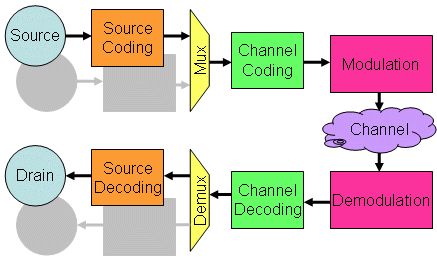[ASICs] [Chip Typen] [Chip Aufbau] [Entwicklung] [Schnittstellen] [Glossar]
[Buffer Types] [Interfaces] [Networks] [IEEE 802 Networks] [Data Lines] [Protocols] [Organazations]
[Line Codes] [Multiplexing] [Modulation] [Line Rates] [Encryption]
 Data Lines
Data Lines
Following pages give an overview how the data is or can be transferred from the signal source (transceiver) to the signal drain (receiver). In most cases it is not possible to transfer the pure data directly from the source to the drain. A principle and general block diagram about signal transmission is drawn on the right side. Several reasons why the information source cannot be directly connected with the drain may be
- Channel characteristics
Pure data is not sufficient for the data channel
and must be converted to a matching level
- there are too long phases of continuously
running zeroes
- the channel capacity can be increased by adding additional signal levels
- the data cannot be put `directly´ on the data line
- frequency band does not fit to the signal bandwidth
- disturbances are too high (noise, interferences of signals, fading, multipath) - Sharing between several users
One channel needs to be shared between many tranmitter/receiver pairs
Physical media with different behavior in terms speed, transfer security, speed and distanceare:
- Wires (e.g. coaxial cables)
- Fiber optical cables
- Wireless channels (terrestrial channels, satellite channels)
These two problems are solved by
- Channel Coding
Channel coding gets rid of the redundancy of the original information. Main target is here to reduce the information to a minimum and save bandwith or resources during the information tranfer process. Redundancy is that portion of the information, which carries no additional information or which is not needed on the receiving side. This can be done with or without loss of information. Examples are: - Fax
- Voice bandwidth reduction to 3.4kHz
- Sound/Music bandwidth reduction to 20kHz
- TV picture frequency to 25 pictures per second
- D/A conversion of analog signals
Beside this also the line speed is well defined. An overview about different line speeds of electrical, optical and air interfaces is given by the following page.
[Home] [ASICs] [Selbstmanagement] [Inselmeer] [Spiele]
[Ich über mich] [Links] [SiteMap] [Disclaimer]